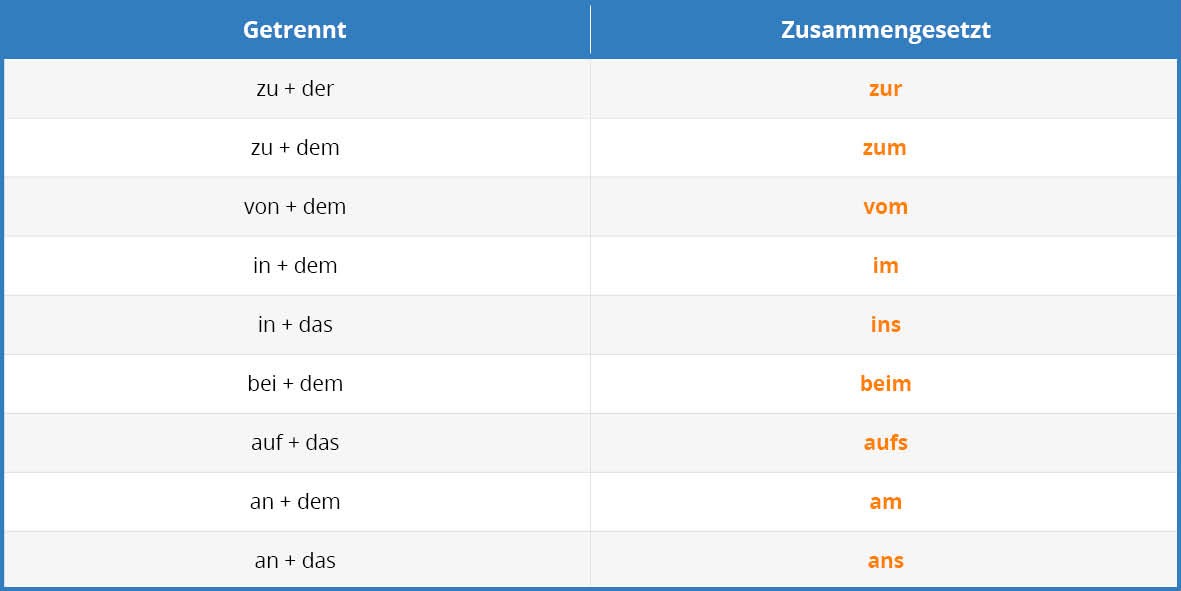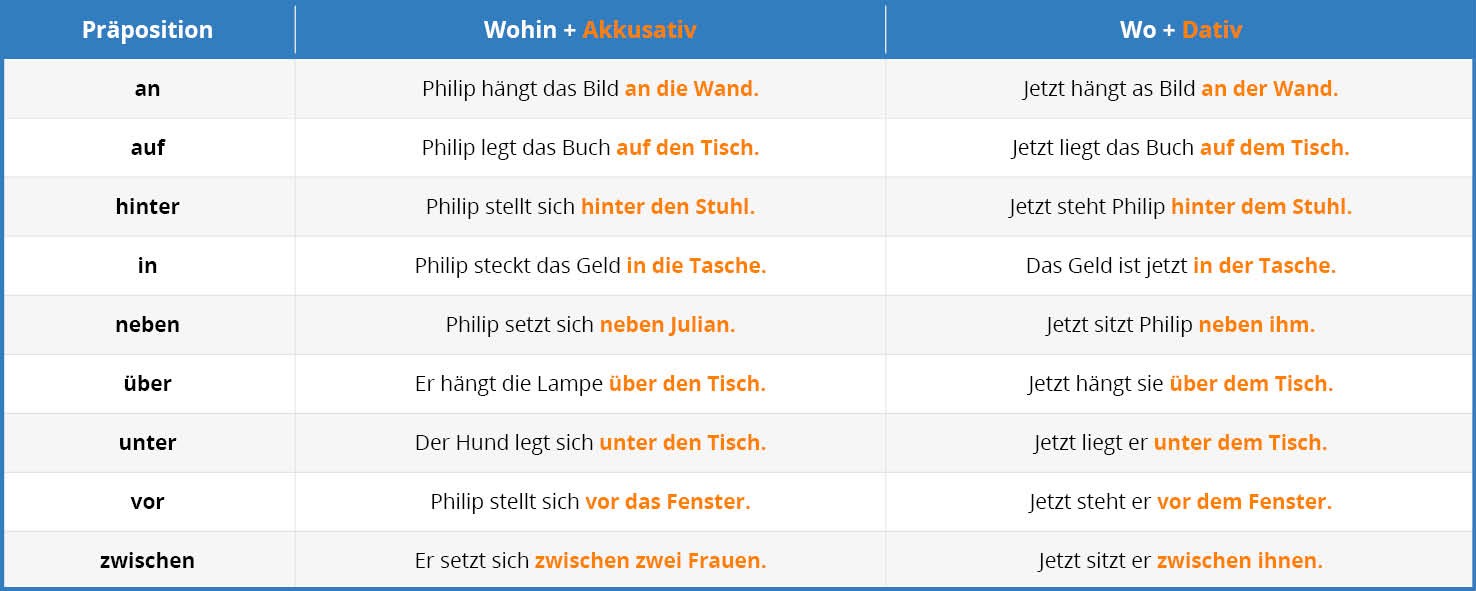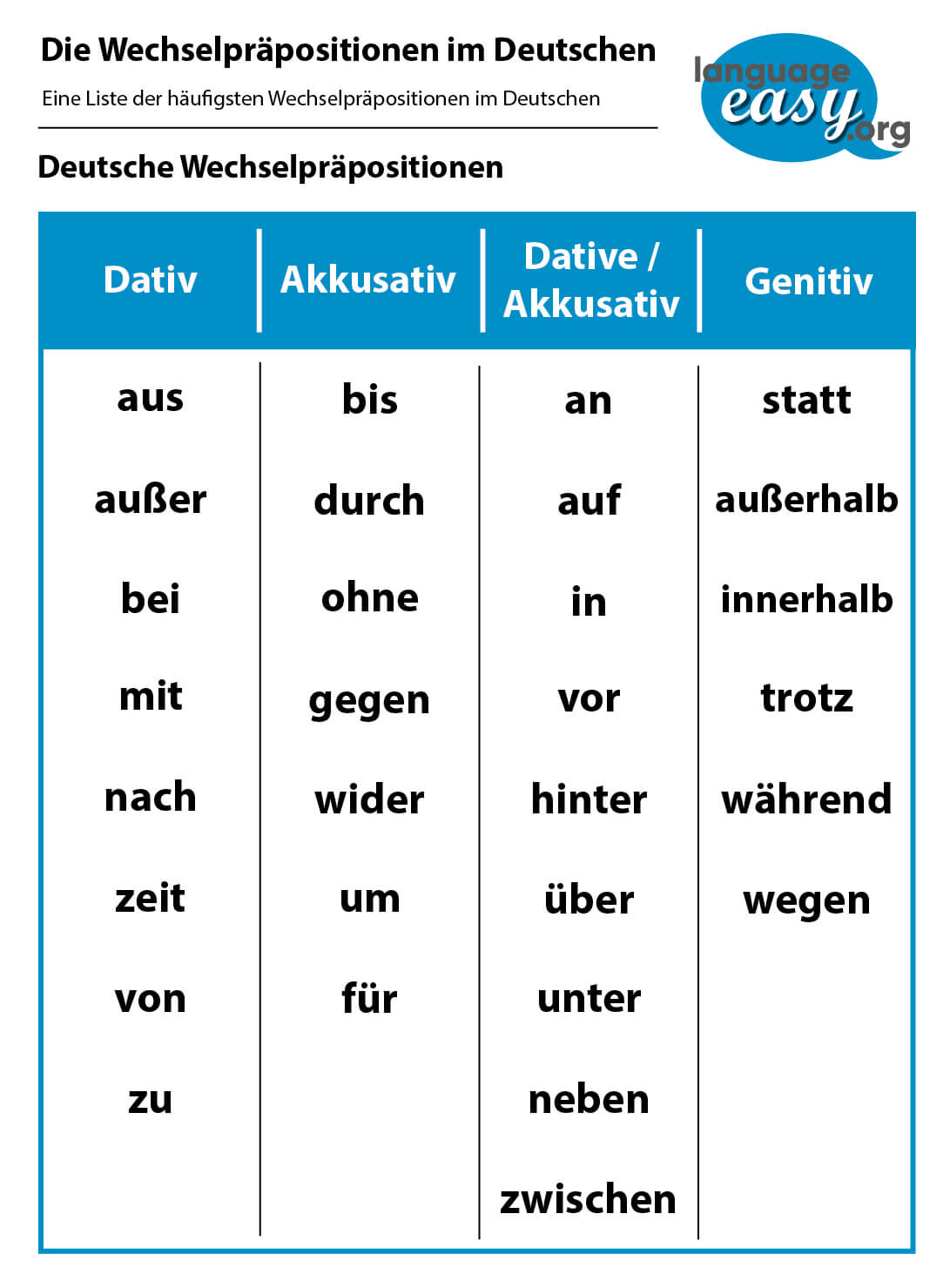German Prepositions
Präpositionen im Deutschen – Erklärungen und Beispiele
German Prepositions – Summary
Zusammenfassung
Preposition describe relations between words and elements of a sentence. There are the following types of prepositions in German:
- Locative prepositions describe three-demensional relations (“auf, in, bei”, …)
- Temporal prepositions describe temporal relations (“am, vor, nach”, …)
- Modal prepositions describe abstract relations (“mit, gemäß, trotz”, …)
- Causal prepositions describe causes and motives (“wegen, aufgrund”, …)
- Prepositions with genitive (“oberhalb, innerhalb, unterhalb, abseits, wegen”, …)
- Prepositions with dative (“mit, von, zu, im, bei, aus, seit, gegenüber”, …)
- Prepositions with accusative (“um, für, bis, durch, gegen, ohne”, …)
- Prepositions with dative and accusative (“in, auf, an, vor, neben, zwischen”, …)
We are surrounded by them. They are everywhere. You can’t hide from them. They will find you anyways.
Well, sounds horrific? But don’t worry, we are just talking about an essential part of nearly every language (at least I think so): Prepositions!
And as you have found your way to language-easy.org, you want to know more about a special kind of prepositions. Well, yes, I’m just going to say it… German prepositions!
Although this topic seems to be rather easy, you have to be conscious about the importance of German prepositions. Logically, they are so important, because they give your German a polish. – Of course, people could understand you, even if you used them in a wrong way. But in order to speak an excellent German, you have to be a master in German prepositions!
Whether you want prepare for you next German class about German prepositions or you simply want to renovate your knowledge about German prepositions you’ve once learned – I hope this page will help you to learn and understand the basics and little details of German prepositions!
The Basics of German Prepositions
Die Grundlage von Präpositionen im Deutschen
First of all, let’s talk about the basic principles and the basic structure of German prepositions. Hopefully, this will make it even easier for you to get started. So, what are German prepositions? Well, let’s see what the good old Cambridge Dictionary tells us about their definition:
“In grammar, a word that is used before a noun, a nounphrase, or a pronoun, connecting it to another word.”
So, as we have cleared up their definition, which, by the way, is absolutely the same for German prepositions, let me show you some examples:
- In, aus, unter, von, mit, über, bis, and so on, and so on…
Well, I think there is no sense in translating these words alone, as you probably know them already and as they are not that important when standing there so lonely. But – using them in a sentence – its whole meaning can be changed by one of these small words.
Unfortunately, we are talking about German prepositions. And you might have noticed, nothing is easy in the German language. So, where is the problem? Well, it’s the cases in German. So, German prepositions affect the case of the noun that follows them. And, as you all know, we have four different cases of which three are of importance now: Genitive, dative and accusative.
Although that saves from thinking about what function the noun is playing in the clause, you are doomed to master them in any case. Simply learn them, there is no way around it.
So, let’s start with our first big chapter of the long history of German prepositions: German prepositions with the Genitive.
German Prepositions with Genitive
Deutsche Präpositionen mit Genitiv
So, let’s start with a rather rare case of German prepositions, the prepositions that are followed by genitive. Although this form is not used that frequently, it is still very important. So, here is a list of the most important prepositions that take genitive with them.
- innerhalb – inside
- trotz – in spite of
- während – during
- wegen – because of
- unweit – not far from
- jenseits – on the other side of
Well, let me tell you a little fun-fact: Actually, most Germans don’t use the genitive with these prepositions. Instead, they use the dative case, although it is grammatically wrong. So, you have to see it from that point of view: Always use these prepositions in the right way! Consequently, people will be impressed by your German, which is even better than the one of mother tongue speakers!
Some Tricks in Between…
Einige Tricks für Zwischendurch…
Just a short trick I want to tell you – it will help you to improve your spoken German. So, you call it contractions: Obviously, you simply have to put the prepositions together with an article in one single word. So, this can be done in spoken and written German.
Here you have a list of prepositions that can be contracted:

German Prepositions with Dative
Deutsche Präpositionen mit Dativ
For sure, you already guessed it: German prepositions that take dative are structured similarly to German prepositions that come with genitive. But, well, that’s also quite clear, they are followed by dative case. Here are some examples for you:
- laut – according to
- seit – for, since
- zu – to
- dank – thanks to
- außer – apart from, except for
- gegenüber – opposite
- mit – with
- nach – to (direction), according to
Well, I can only give you two important tips when learning German prepositions: Just make sure that you learn them together with the case that follows them. So, you can either do that with your vocabulary you learn or forming some sentences where you use these prepositions you want to master.
German Prepositions with Accusative
Deutsche Präpositionen mit Akkusativ
At last, there are a lot of prepositions that take the accusative case. Well, similar to all the other German preposition with genitive or dative, these prepositions always take the accusative case, independent of their position in the sentence. So, here you have the list of our examples:
- gegen – towards, against
- entlang – along
- bis – until, by, up to
- ohne – without
- durch – through, across
- für – for
German Two-case Prepositions
Wechselpräpositionen im Deutschen
Well, I think we have reached the most difficult part of German prepositions, the so-called two-case prepositions.
But don’t panic, there is a rule behind all that you can follow. So, once you understand this rule, mastering two-case prepositions should be no problem for you.
So, the rule is quite simple:
If you’re trying to express movement (direction), use the accusative. If you’re trying to state where something is (position), use the dative.
And here you have an example:
- “Ich lege das Buch auf den Tisch.” (I put the book on the table.) As “auf” expresses the movement, you have to use the accusative case after that.
- “Das Buch liegt auf dem Tisch.” (The book is lying on the table.) Here, “auf” expresses a position. So, you have to use dative case.
In the following, I’d like to present a complete list of German two-case prepositions.

Unfortunately, well, maybe you will think “Luckily…”, we have come to the end of this article. Finally, I hope, you could get the basic ideas of German prepositions and their different types. Logically, prepositions are like the rest of German grammar – you simply have to sit down at your desk and study, study, study. But if you understand the rules and learn your vocabulary the right way, you will master German preposition without any problems!
Exercises
Übungen



